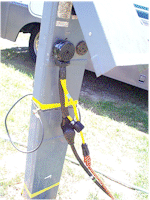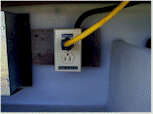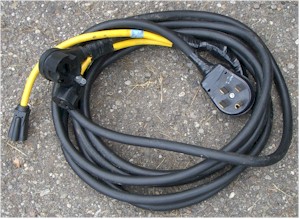Wolf's Motorhome Modifications
... and Other Stuff
50 Amp Wiring Modification
Typical 50 Amp Service
On many motorhomes, electrical service for a 50 amp line is split
into two parts. The first part, the 30 amp side of the socket, goes to the normal,
everyday things we all use. It includes one of two air conditioners. The other
side of the socket goes to the second air conditioner.
Now let's get the concept and not get hung up on "code".
A "code" 50 amp outlet is one that will provide for you 50 amps of 240
volt AC. That outlet can also provide two separate 50 amp 110 volt feeds. If
your driving a coach with electric cooktops (people in the newsgroups say they exist,
apparently!) you may need a 50 amp 240 volt service. The normal motorhome doesn't.
It runs all but the back air from one side and it runs the rear air on the other.
Based on this, if you were to put in a plug for your motorhome, you
might want to consider that a more conservative, safer approach might be of benefit.
You might be better served with a 30 amp and 20 amp breaker at the supply if you
were going to draw but 30 and 20 amps.
Unless you need a lot of power in some other application; unless
you're doing commercial welding or some such, the installation of a code outlet is a big
waste of money and can be much more dangerous to you and your coach.
What I Wanted
Most campgrounds I go to have a box that contains a 30 amp plug and
a 20 amp plug. Most boxes like that are run from a 30 amp breaker on a main panel.
Occasionally, I find a 50 amp plug is available.
If you're in a campground that has a box with a 20 and a 30 amp
receptacle that is run off a breaker in the main box that's only 30 amps, you CAN NOT pull
50 amps. But ...
I wanted to have my motorhome wired for typical service but wanted
to take advantage of 50 amps when it was available. I wanted a 30 amp plug for
normal service. If I had 50 amps available, I wanted to run a second heavy cord to
suck the other 20 amps.
What I Did
I left my 30 amp service as is. I located the power line that
goes to my second air conditioner. I split that line
 and ran it to a box in
my utility compartment. I installed a switch that allows me to switch that air
conditioner from the generator to the air or from a plug I installed to the air. I
could now flip a switch the other air conditioner would draw electricity from the plug
that I added rather than the generator.
and ran it to a box in
my utility compartment. I installed a switch that allows me to switch that air
conditioner from the generator to the air or from a plug I installed to the air. I
could now flip a switch the other air conditioner would draw electricity from the plug
that I added rather than the generator.
I made a 50 amp male plug adapter. This adapter has three
cords coming from the male plug. One cord goes to a normal 30 amp socket. I
plug the 30 amp cord from the motorhome into that. The second cord comes from the
other side of the 50 amp outlet; the 20 amp side. It terminates into a 110 volt
socket. I run my second 10 gauge cord to that socket. I now have 50 amp
service. The third cord goes to the same place as the first but is terminated in a
110 volt outlet. This allows me maximum flexibility in the event I wanted to use the
50 as two added regular outlets.
Beware, though, as the supplies may allow 50 amps service
to a 20 amp line. You will want to protect the lines in that case with
your own circuit breaker. You can do this by utilizing a power strip that
incorporates a circuit breaker or installing a separate breaker box.
Easy, No?
Well ... no. I thought it was easy. Actually, there is a
ground fault problem that occurred. The only place the neutral and the ground should
be bound together is at the service entrance. We can all agree on that. What
of a generator? Neutral IS bound to ground at that point too! Hence, any
attempt to plug the 20 amp side of my modification into a ground fault plug will see the
neutral and ground bonding at the generator and pop the breaker. Rightfully
so! Everyone is using ground fault plugs now.
Back to the drawing board I went. Now I needed a DOUBLE POLE
double throw switch. Hmmm ... they don't make them (other than in toggle switches
and they don't bind to 10 gauge wire so well). I could put in a dual switch
combination. This is two switches, both double throw. I switch the hot with
the one switch and the neutral with the
 other. The grounds are bound together.
I could then cemented a bridge between the switches so they both had to be switched
together. Now would have no ground fault problem. What a PAIN.
other. The grounds are bound together.
I could then cemented a bridge between the switches so they both had to be switched
together. Now would have no ground fault problem. What a PAIN.
Instead,
I simply added an electrical outlet to the utility compartment that leads to the
generator's supply. I took the power line going to the rear air and put a plug on
the end of it. If I want the rear air to be powered by the generator, I plug it into
the outlet. If I want to run it off the campground supply, I unplug the plug and
plug it into a heavy, short cord I have for the purpose. EASY. IT WORKS.
What I Actually Do
I normally connect both the 30 and 20 into even the 30/20 outlet
boxes. I do this so I can run my rear air conditioner (shutting off the front one)
when we are watching TV or working on web pages. When leaving the dogs I can set the
rear air about 10 degrees higher than the front. If the front fails, the rear will
take over.
A Problem
Notice that there are situations in which you will not
have the protection of a proper sized breaker! You need to insure that the
source you're plugging into contains a breaker and that breaker needs to protect
your equipment! Plugging this into a 50 amp supply would be
dangerous. As virtually all the new boxes contain 15 or 20 amp 110 VAC
breakers on the 110 outlets, this has not been a problem. Plugging into a
50 amp supply requires you protect your equipment with a suitable breaker.
You can add a breaker box or utilize a power strip which incorporates a breaker.
It DOES Work
For some reason, I have newsgroup know-it-alls bug me about this
one, too. Well, it works. I am sitting in a Knox, Pennsylvania campground
running both airs. It's about 90 out and, well, it's very, very cool in here.
For the DEDICATED
Check out Bob Hatch's 50 amp conversion pages. If
you want to put 50 amp service into a 30 amp box, he can offer quite a bit of
help. Bob has quite a few other pages of value on his site.
http://www.bobhatch.com/electricStuff/30to50amp.htm
CHANGES MADE MAY, 2005
 I
have run into two problems with the above adapter. The first comes on
shared utility poles. Having a 50 amp line insures the hole is filled and
the latecomer can't insist you change the adapter to the 30 amp plug. The
second comes from parks that allow only one cord. I have no idea why such
a limitation is in place but suspect an inquiry would result in my finding a
really anal owner. I've never asked. At any rate, if you're reading
this so you don't make the same mistakes others have made, you're in luck.
I changed the above adapter into a cord. Now it appears I am a 50 amp
motorhome and all disputes are resolved. Inside the compartment my 30 amp
cord is still into the 30 amp side and the air is off the other side. It
works great.
I
have run into two problems with the above adapter. The first comes on
shared utility poles. Having a 50 amp line insures the hole is filled and
the latecomer can't insist you change the adapter to the 30 amp plug. The
second comes from parks that allow only one cord. I have no idea why such
a limitation is in place but suspect an inquiry would result in my finding a
really anal owner. I've never asked. At any rate, if you're reading
this so you don't make the same mistakes others have made, you're in luck.
I changed the above adapter into a cord. Now it appears I am a 50 amp
motorhome and all disputes are resolved. Inside the compartment my 30 amp
cord is still into the 30 amp side and the air is off the other side. It
works great.
 and ran it to a box in
my utility compartment. I installed a switch that allows me to switch that air
conditioner from the generator to the air or from a plug I installed to the air. I
could now flip a switch the other air conditioner would draw electricity from the plug
that I added rather than the generator.
and ran it to a box in
my utility compartment. I installed a switch that allows me to switch that air
conditioner from the generator to the air or from a plug I installed to the air. I
could now flip a switch the other air conditioner would draw electricity from the plug
that I added rather than the generator. other. The grounds are bound together.
I could then cemented a bridge between the switches so they both had to be switched
together. Now would have no ground fault problem. What a PAIN.
other. The grounds are bound together.
I could then cemented a bridge between the switches so they both had to be switched
together. Now would have no ground fault problem. What a PAIN.
